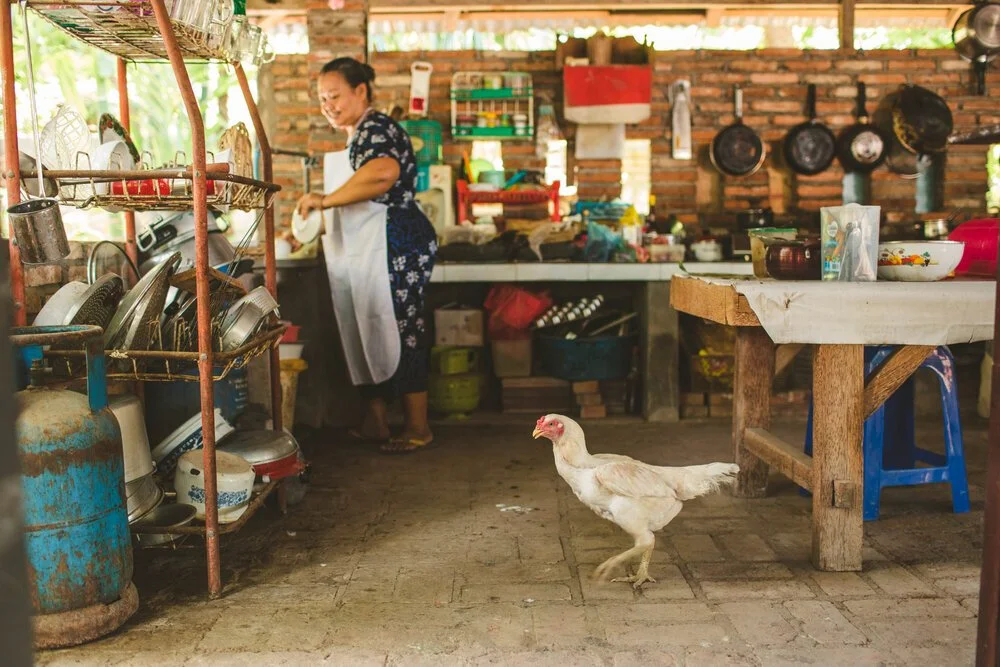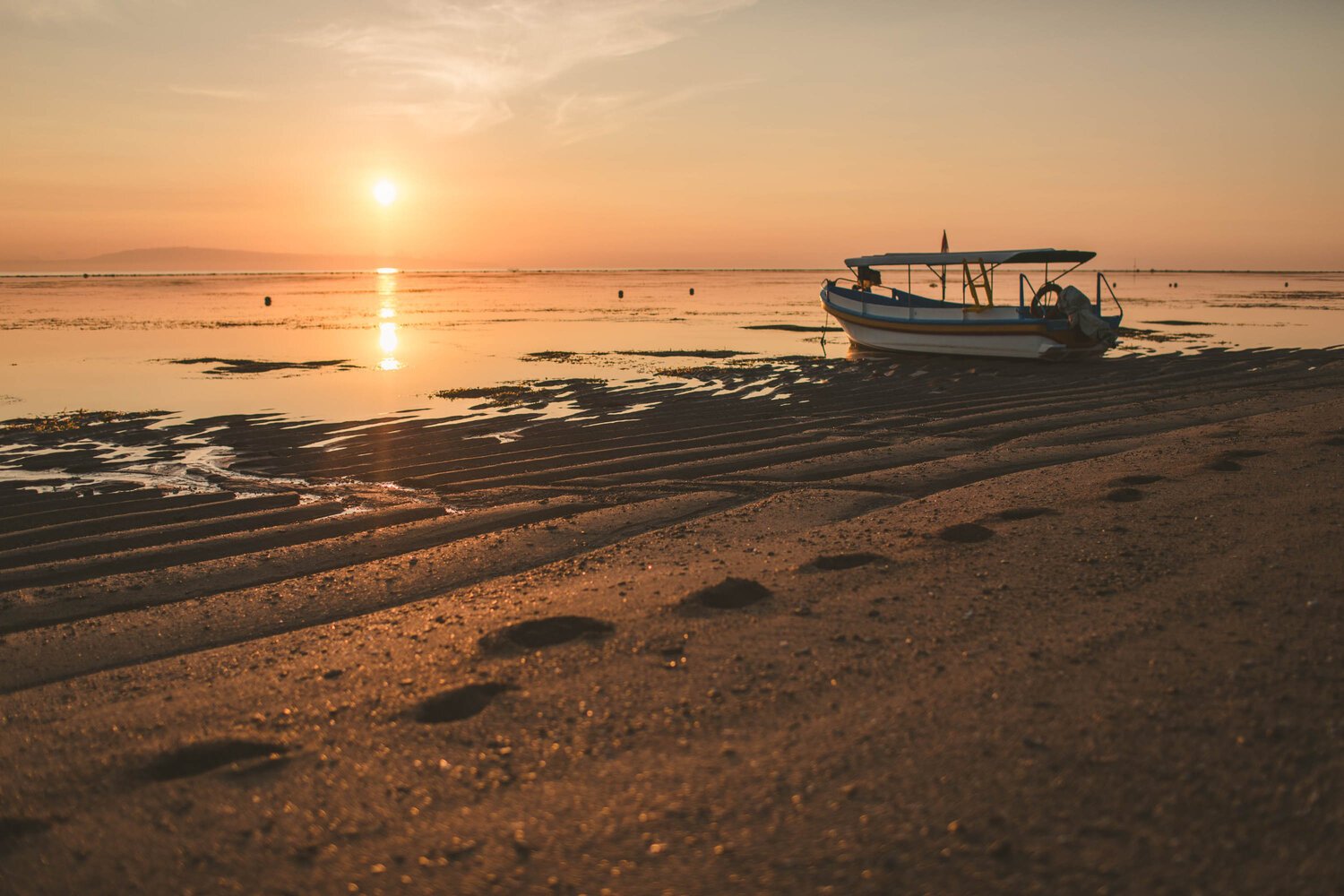Beyond the Sambals of Bali
If you’ve ever longed to visit a place where the beauty is endless, both in the landscapes and people who live there, you must visit Bali. I had few expectations, other than photos I’d seen of the plush landscapes and exotic temples. Exploring Bali with a local food expert was the best way to see the island and taste everything Bali is known for. Diana Von Cranach has a British passport, but has lived in Bali for over thirty years. She’s an interior designer, chef, restaurant consultant, and historian of all things Bali.
She owns a boutique hotel called Puri Ganesha By The Beach on the northwest coast of Bali, in the village of Pemuteran. Her Balinese-style villas face the beach with fishing boats anchored on the horizon every morning. Each structure of her property has intricate thatch roofs, woven with precise accuracy and beauty. Hanging lamps of woven bamboo and thick grass fringe swing from the beams in every corner. And ancient Balinese artifacts and paintings are strategically placed on the walls amidst antique furniture. Diana’s colorful personality comes out in every attention to detail in her decor.
Although she told stories about the dramatic history of Bali, including natural disasters, terrorism, and rebellions, her enthusiasm came alive when she spoke about Balinese food. She has a beautiful pavilion at her hotel where she teaches cooking classes to her guests. When I arrived for my first lesson, the large wooden table was covered with water jugs full of greens, and a basket laden with chiles, garlic, ginger, galangal, seeds, and spices. Her chef, Ketut, was there standing in front of a shallow mortar and pestle, called a cobek, made of lava rock and he pointed to my own set where I would help him prepare a variety of sambals.
Sambal is a condiment essential in Indonesian cooking. There are many variations, and it has many uses. The common ingredient in every sambal is chilles, although they don’t have to be terribly hot. The basic Indonesian sambal is sambal ulek, an uncooked mixture made by crushing chillies with salt, lime, and sometimes vinegar. There are so many variations of sambals, and we used them with chicken, shrimp, fish, and salads. One of my favorites was a peanut sauce made with local peanuts, lemongrass, lime leaves, and spices. After crushing them in the cobek, we fried it in coconut oil to be used as a dipping sauce. We used it to dip fried tempe, the soybean tofu that is so commonly eaten in Indonesia. It also makes a delicious dressing over fresh greens and mango. I prefer my sambal on the spicy side, so I tended to add more chillies.
Diana is a vegetarian, and she’s spent a lot of time creating recipes using the native greens and vegetables to make soups, salads, and veggies steamed with coconut in banana leaves. We spent days cooking and trying different dishes with the many sambals and spice mixtures (called bumbu) to flavor nearly everything. Perhaps the most famous dish of Bali is Ayam Betutu, which is slow cooked spicy chicken wrapped in banana leaves. We ate it with steamed rice and sambal matah, a raw sambal made with lemongrass, shallots, and garlic.
Diana’s husband, Gusti, a native of Bali was our driver on the day we decided to go to Java, the island just a few kilometers from Diana’s hotel. We had to drive onto a ferry for the thirty minute ride to Java, the island best known for its coffee. We drove through an old Dutch village and arrived at a coffee plantation in Banyuwangi called Kaliklatak Coffee, which was built by a Dutch family in 1910 and turned into a coffee and rubber tree plantation in 1925.
We visited the building where women were sorting through wooden boxes filled with coffee beans. The best beans were tossed into burlap bags, and the beans that had any damage were tossed into a tray to be ground and sold to secondary markets. They were so happy to see us, and proud to show us their work. I was with my photographer Valerie, and the women loved seeing the photos she’d taken with her camera. Penno, the plantation manager, showed us the buildings where the sap from rubber trees is processed and smoked for twenty four hours to become sheets of rubber for industrial use. They supply the Ferrari factory the floor mats for their cars.
The five of us climbed into the back of an all-terrain vehicle for a bumpy ride on a road up the mountain through the coffee fields dotted with nutmeg and clove trees. There were also groves of cinnamon trees, which were in full bloom with pink blossoms. Penno stopped to show me how they harvest cinnamon by slicing strips of bark from the tree and laying them out to dry until they curl up like scrolls. When we arrived at the top of the mountain there was a picnic table under a veranda overlooking the valley where we sat and drank coffee from the thermos Penno brought. The cool breeze was certainly a treat after the tropical humidity in Bali.
Before returning to the ferry we drove to the city center of Banyuwangi to visit the market. I bought some long cinnamon sticks from a Muslin spice merchant who broke each piece and smelled it before putting it into my bag. She wanted to make sure it was all fresh and fragrant.
Back in Bali, we packed our bags, and the following day Diana and Gusti drove us to the village of Singaraja (which means Lion King) where we visited the home of Gusti’s brother and his extended family. They lived in a compound of several houses belonging to various family members, and the kitchen was centered in the open air with a thatch roof. Gusti’s sister in law, Nina was preparing for a cooking class to show me some of her specialties. The kitchen had a large table in the center of the room where Nina prepared food every day for the entire family. There was a small sink and cooktop in the corner, and two small tables with chairs in the other corners. Chickens and cats roamed in and out, looking for any scraps we might be willing to spare.
Nina’s grandson had a small grill the size of a brick where he was burning dried coconut shells for grilling the fish satay we would prepare. Instead of plates, Nina had round baskets lined with banana leaves that had been cut into circles. The ingredients we used were neatly stacked on rows of banana leaf plates. We made two soups, one with tuna and one with greens. The broth was made with coconut water. We marinated cubes of fish with turmeric and chilies, then threaded them on bamboo sticks to be grilled outside. We rubbed spices into filets of fish and wrapped them in banana leaves. These were also grilled outside until the leaves were black and the fish was tender. For dessert, Nina cooked red sticky rice in coconut water and added palm sugar and coconut milk.
Gusti stayed at his family’s house while Diana, Valerie, and I drove to Ubud, the city near the center of Bali. On the way, we stopped at a coffee shop where we had gorgeous views of the volcanoes in the distance. The road was narrow and winding as we drove through the mountains, and the villages along the way were built very near to the road. It was a Sunday, and there were several ceremonies happening that we got to witness as we slowly drove past. One group of people were worshiping in the street, bowing with their faces. Another village had just celebrated a wedding, and the entire town was lining the streets. As we drove by, I was taking a video, and people were waving and smiling for my camera.
Bali is known for its beautiful textiles, like the Ikat weavings, batik dyed cottons, and woven tapestries with tiny shells embroidered into patterns. We visited the Berdikari Handwoven Cloth Factory in Singaraja where they had massive wooden looms set with colorful silk and cotton threads. There was a man sitting on the floor spinning fibers into thread with a handle connected to two bicycle wheels. Four women sat at the looms making cloth in the traditional method of Ikat. It was fascinating to watch the rhythmic motions of wooden beams as they magically formed beautiful designs in the cloth. In Ubud at the shop, Ikatbatk I nearly got lost in the colorful stacks of hand-dyed fabrics and wall coverings. Many pieces were hand-quilted with tiny stitches of cotton thread, and tassels at each corner.
One cannot visit Bali without seeing the rice fields where the ancient methods of growing rice has been practiced since the 9th century. A rice farmer named Madé took us on a three hour trek on the outskirts of Ubud through the rice fields, explaining the Subak philosophy of growing rice and irrigation in a cooperative community. Subak uses the philosophy of Tri Hita Karana, which means three things cause the creation of happiness and well-being: harmonious relationship between humans and God, harmonious relationship between human and his neighbor, and harmonious relationship between human and nature. The rice farmers work closely together, and rely on the leaders of the temples dedicated solely to the rice fields. Madé proudly described the methods of their unique irrigation system, using trenches and terraces to distribute rain water to every farmer’s field. Unfortunately, many farmers are giving up their fields by selling to foreigners for hotel development.
After several days in the touristy city of Ubud we moved south to the resort community of Sanur. It was much more relaxed and slower paced. Each day for lunch we found a roadside cafe called a warung, usually run by a husband and wife or several women. At first I was skeptical when we sat down just a few feet from the street at a table covered in plastic. Sometimes the food was already prepared, sitting in containers with bowls of sambal and pickled vegetables. Other times the cook was busily preparing our orders over a single burner while another person washed dishes from a garden hose. Each time I thought that if I was going to get ill from food, surely this was it. But, each time the food was the best I’d ever eaten. And, of course I never got ill. My favorite was a place called Warung Sari Agung Singaraja, where three women served us fish satay, floss chicken, green beans, and rice. The spicy sambal was so good, I kept asking for more. The women were thrilled we had come to their restaurant, and asked if they could take our photos. I still think about the food I ate at those warungs, and I’d choose their food over a five star restaurant any day.
More and more tourists are visiting Bali every year, and the traffic is proof that people from all over the world have discovered the island of paradise. Diana can’t wait for me to return so she can show me the “east coast” where there are ancient trading villages, hand weaving artists, goldsmiths, and beautiful mountain scenery. She taught me so much about Balinese food and culture, and with all the recipes she shared, I plan to become a sambal aficionado.






















































